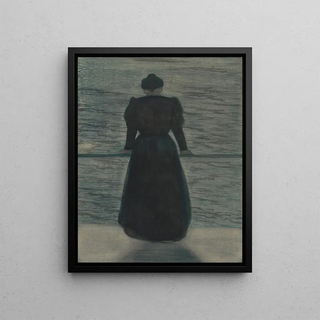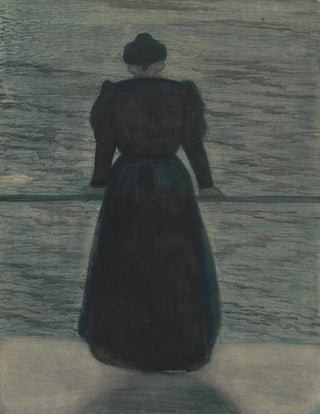Art print | Woman by the Sea - Léon Spilliaert


View from behind

Frame (optional)
In the fascinating universe of art, some works transcend time and space, captivating viewers with their depth and emotion. "Femme au bord de la mer" by Léon Spilliaert is one of those creations that evoke an atmosphere both melancholic and contemplative. This painting, created in 1907, immerses us in a maritime landscape where solitude and reflection blend harmoniously. The female figure, an elongated silhouette, appears both close and distant—a poignant metaphor for the human soul in the face of nature's vastness. The sea, both calm and tumultuous, becomes the mirror of inner thoughts, inviting the viewer to deep introspection.
Style and uniqueness of the artwork
Spilliaert's style is distinguished by a bold use of light and shadow, creating a dreamlike atmosphere that envelops his subjects with an almost mystical aura. In "Femme au bord de la mer," dark colors and delicate shades of blue evoke the depth of the ocean and the weight of thoughts. The composition is carefully orchestrated, with the female figure placed in the foreground, immediately drawing the eye. The contrast between the human silhouette and the immensity of the sea highlights the fragility of existence in the face of nature's grandeur. Spilliaert thus manages to capture a universal emotion—the feeling of isolation and the search for oneself—while offering a visual aesthetic that remains etched in memory.
The artist and his influence
Léon Spilliaert, born in Belgium in 1881, is an emblematic figure of symbolism and expressionism. His work is marked by a constant search for identity and the human condition. Influenced by the landscapes of his hometown, Ostend, he develops a unique style that combines introspection and representation of nature. Spilliaert has established himself as a pioneer, exploring themes that still resonate today. His ability to translate complex emotions through simple forms and nuanced colors has inspired many contemporary artists. Reflecting the existential concerns of his time

Matte finish

View from behind

Frame (optional)
In the fascinating universe of art, some works transcend time and space, captivating viewers with their depth and emotion. "Femme au bord de la mer" by Léon Spilliaert is one of those creations that evoke an atmosphere both melancholic and contemplative. This painting, created in 1907, immerses us in a maritime landscape where solitude and reflection blend harmoniously. The female figure, an elongated silhouette, appears both close and distant—a poignant metaphor for the human soul in the face of nature's vastness. The sea, both calm and tumultuous, becomes the mirror of inner thoughts, inviting the viewer to deep introspection.
Style and uniqueness of the artwork
Spilliaert's style is distinguished by a bold use of light and shadow, creating a dreamlike atmosphere that envelops his subjects with an almost mystical aura. In "Femme au bord de la mer," dark colors and delicate shades of blue evoke the depth of the ocean and the weight of thoughts. The composition is carefully orchestrated, with the female figure placed in the foreground, immediately drawing the eye. The contrast between the human silhouette and the immensity of the sea highlights the fragility of existence in the face of nature's grandeur. Spilliaert thus manages to capture a universal emotion—the feeling of isolation and the search for oneself—while offering a visual aesthetic that remains etched in memory.
The artist and his influence
Léon Spilliaert, born in Belgium in 1881, is an emblematic figure of symbolism and expressionism. His work is marked by a constant search for identity and the human condition. Influenced by the landscapes of his hometown, Ostend, he develops a unique style that combines introspection and representation of nature. Spilliaert has established himself as a pioneer, exploring themes that still resonate today. His ability to translate complex emotions through simple forms and nuanced colors has inspired many contemporary artists. Reflecting the existential concerns of his time






